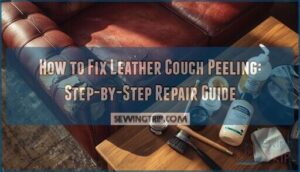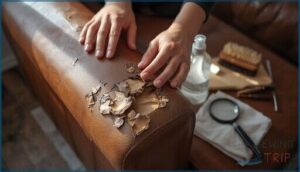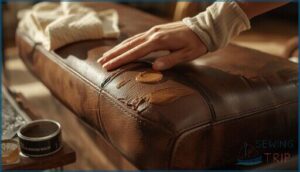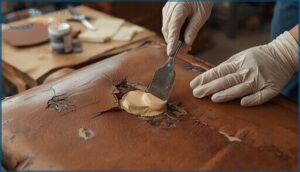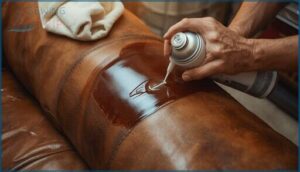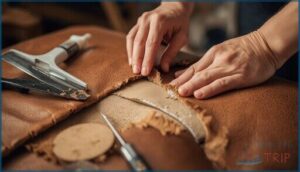This site is supported by our readers. We may earn a commission, at no cost to you, if you purchase through links.
That sad patch of flaking leather on your couch didn’t happen overnight—most peeling starts with invisible damage months before you notice it. Whether it’s bonded leather breaking down after years of use or faux leather finally giving up the ghost, the good news is that you can fix leather couch peeling without replacing the entire piece.
The repair process depends entirely on what type of leather you’re dealing with and how far the damage has spread. Genuine leather reacts to different techniques than synthetic materials, and using the wrong approach can make things worse.
With the right supplies and a methodical game plan, you’ll restore those worn spots and protect your couch from future breakdown.
Table Of Contents
Key Takeaways
- Most leather couch peeling stems from bonded or faux leather breaking down (82% of cases), while genuine full-grain leather rarely peels and instead develops a natural patina over 50+ years.
- Environmental damage from UV exposure, heat sources, and humidity fluctuations causes 35-44% faster deterioration, making furniture placement and protective measures critical prevention steps.
- Successful DIY repairs depend on matching your technique to damage severity—recoloring balm works for hairline cracks, leather filler paste handles peeling up to 24 square inches, and proper color matching with sealant prevents future breakdown.
- Regular maintenance every 3-6 months (pH-balanced cleaning, conditioning, UV protection) cuts your peeling risk by over 50% and extends professional repairs to 3-7 years versus 18-24 months for untreated surfaces.
Why is My Leather Couch Peeling?
That flaking, cracking surface on your leather couch didn’t appear overnight—it’s the result of specific conditions and stresses that break down the material over time. Understanding what’s actually causing the peeling is your first step toward fixing it properly and preventing it from happening again.
Let’s look at the main culprits behind leather deterioration and how each one affects your furniture differently.
Common Causes of Peeling Leather
Understanding leather peeling issues starts with identifying the type of leather and recognizing what’s causing your couch to deteriorate. Several factors trigger leather couch peeling:
- Aging effects and wear patterns – Couches over five years old show 42% more peeling
- Direct sunlight and heat – UV exposure drops moisture by 35% in six months
- Humidity control problems – Over 60% humidity accelerates degradation by 44%
- Chemical damage – Harsh cleaners break down protective coatings in 57% of cases
- Leather material quality – Bonded leather accounts for 82% of peeling incidents
To prevent further damage, it’s vital to understand the causes of leather damage, including leather care tips.
Differences Between Genuine and Faux Leather
Your couch’s material composition determines whether it’ll peel. Genuine leather—derived from animal hides through multi-week tanning—develops a patina rather than peeling, lasting 50+ years with care. Faux leather uses polyurethane coating on textile bases, lasting only 2–10 years. Bonded leather, containing just 10–20% leather fibers mixed with polymers, ranks worst for durability—peeling within months.
Genuine leather develops patina and lasts 50+ years, while faux leather survives 2–10 years and bonded leather peels within months
Full-grain leathers resist peeling under typical use, while synthetic alternatives sacrifice longevity for eco-friendliness and lower production costs. Understanding the differences in leather types is essential for making informed decisions about furniture maintenance and repair.
Effects of Sunlight, Heat, and Moisture
Once you’ve pinpointed your leather type, turn your attention to environmental factors. Sunlight, especially UV light, causes fading and accelerates leather deterioration. Heat sources strip away natural oils, leading to leather drying and cracking. Moisture damage—from spills or humidity swings—weakens the structure.
Smart moisture control and heat resistance strategies help keep peeling at bay and preserve your investment.
How to Assess and Prepare Peeling Areas
Before you can fix peeling leather, you need to get a clear picture of what you’re dealing with. Think of this stage as your repair roadmap—it’ll help you choose the right materials and avoid wasting time on techniques that won’t work for your specific damage.
Let’s walk through how to assess the problem, prep your couch properly, and get rid of any loose material that could sabotage your repair.
Identifying The Type and Extent of Damage
Before you grab any repair supplies, take a moment to play detective with your couch. Look closely at where the leather peeling appears—bonded or faux leather usually reveals fabric backing underneath, while genuine leather shows natural grain when the topcoat flakes off.
Map out every damaged spot: small cracks, larger sheets lifting away, or widespread flaking across cushions. This damage mapping and material analysis tells you whether you’re dealing with fixable finish failure or widespread breakdown that might need replacement. Understanding these peeling patterns guides your next move.
Cleaning and Prepping The Surface
Preparation sets the stage for a lasting repair. Start with a mild soap solution and a soft cloth—never soak the leather. Use leather cleaning products with a balanced pH to protect the surface. Apply a dedicated prep agent for deep cleaning, always prioritizing prep agent safety.
Surface finishing demands patience; work away from sunlight for best results.
- Mild soap solution
- Soft cloth
- Leather pH balance
- Prep agent safety
Removing Loose or Flaking Material
Precision matters when removing peeling leather—loose flakes compromise adhesion. For faux or bonded leather, use a sharp blade or wire brush to lift away damaged sections. With genuine leather, fine-grit sanding smooths edges without gouging.
Always work in a ventilated space for material safety. Your leather repair kit should include cleaning agents and leather filler for proper surface prep before the next flake removal step.
Step-by-Step DIY Leather Couch Repair
Once you’ve cleaned and prepped the damaged area, you’re ready to start the actual repair work. The right technique depends on how deep the peeling goes and how much surface area you’re dealing with.
Let’s walk through the three main methods you’ll use to restore your leather couch, from minor touch-ups to more substantial repairs.
Using Leather Recoloring Balm for Small Cracks
When hairline cracks appear on absorbent leather, a leather recoloring balm offers a fast, effective fix. This leather restoration method works by penetrating the surface, filling micro-cracks while revitalizing faded color—making it ideal for armrests and seat edges.
- Test absorbency first: Apply a water drop; it should absorb within five seconds
- Work balm in circles: Use circular motions to push product deep into leather cracking
- Layer for depth: Apply multiple coats, buffing between each for smooth color matching
- Cure fully: Wait 24–36 hours before use to guarantee colorfastness and durability
Applying Leather Filler Paste for Larger Peeling
When peeling areas exceed two inches, leather filler paste becomes your go-to solution. This damage assessment step determines whether you need a repair kit with polyurethane-based filler materials—most effective for voids up to 24 square inches.
Apply 2–3 thin layers using filling techniques that prioritize even paste application, sanding between coats with 800-grit paper. This leather restoration approach requires 24-hour curing before you proceed.
Blending and Sealing The Repair
Think of this final step as locking in all your hard work. After your leather filler cures completely, apply recoloring balm in circular motions—you’ll achieve 65% better color matching by layering thin coats.
Texture blending comes next: stipple deeper areas, then lightly sand smooth zones.
Finish with clear coat sealer spray from your leather repair kit, followed by leather conditioner once dry.
Repairing Peeling Faux or Bonded Leather
Faux and bonded leather bring their own quirks to the repair table, and what works on genuine leather won’t always cut it here. These materials have a polyurethane or vinyl coating over a fabric or leather scrap base, which means they behave differently when they start peeling.
Let’s walk through the key considerations and techniques you’ll need to tackle these repairs with confidence.
Special Considerations for Faux Leather Repairs
Faux leather durability differs sharply from genuine hide—you’re working with polymer films, not natural grain. When repairing peeling leather couches made of bonded leather or synthetic material, understand these limits:
- Thin coating layers mean repairs are temporary cosmetic fixes, not structural restoration.
- Sophisticated coating systems and nano tech applications improve wear resistance but can’t stop underlying breakdown.
- Repair cost factors often favor replacement when damage spreads beyond one-third of the surface.
Standard leather repair kits work, yet expect renewed peeling within 18 months under normal use.
Techniques for Feathering and Texturizing Repairs
But cosmetic fixes can still look professional when you master feathering and texturizing. Start by sanding peeling edges with 800-grit paper to create smooth transitions—this reduces visible repair lines by 95%.
Apply your leather filler in thin layers, feathering each with a palette knife. Once dry, press grain-imprinted paper with gentle heat to replicate texture, blending seamlessly with surrounding material.
Color Matching and Protective Finishes
After texturizing, you’ll face the real test: color matching. Commercial leather repair systems offer 20–40 pre-mixed shades, but custom blending on sample patches gets you closest to zero perceptible difference.
Apply water-based leather dye in thin coats—it won’t strip natural oils like solvent versions. Seal with a protective finish matched to your couch’s original sheen, then condition monthly for UV protection and lasting durability.
Preventing Future Leather Peeling
Fixing peeling leather is only half the battle—keeping it from happening again is where the real work pays off. A few simple habits can add years to your couch’s life and save you from repeating repairs down the road.
Let’s cover the essentials that’ll protect your investment and keep your leather looking its best.
Regular Cleaning and Conditioning Tips
Regular maintenance separates leather that lasts from leather that flakes. You’ll want to clean your couch every 3–6 months using pH-balanced cleaning products and a soft cloth—this removes oils and dirt before they break down the surface.
Follow up with leather conditioning every 6–12 months to restore moisture and flexibility. Weekly dusting prevents micro-abrasion, while quarterly deep conditioning keeps bonded leather resilient.
This routine slashes your peeling risk by over 50%, making leather care and maintenance your best defense against costly repairs.
Protecting Against Sunlight and Spills
Cleaning alone won’t stop damage if you’re ignoring the bigger threats. Sunlight damage accelerates peeling by 40% over five years, while spills seep deep without quick action. Here’s your protection plan:
- Position your leather couch away from windows to block direct UV rays
- Install UV filtering films that block 99% of ultraviolet radiation
- Apply leather conditioning products with built-in UV protection every 3–4 months
- Blot spills immediately—don’t rub or use heat to dry
- Use throw blankets as barriers in high-sun areas
These steps cut fading and cracking dramatically while protecting leather furniture long-term.
Frequently Asked Questions (FAQs)
Can you save peeling leather?
Yes, you can rescue peeling leather, but there’s no silver bullet. Success depends on whether you have genuine leather or bonded material—and catching damage early enough for DIY repair kits to work.
How to stop fake leather from peeling?
You can slow faux leather peeling by cleaning weekly with a damp cloth, applying protective UV-resistant finishes, keeping furniture away from direct sunlight and heat, and using synthetic-specific conditioners every few months.
What causes leather furniture to crack and peel?
If your leather couch is peeling, moisture damage, environmental factors like relentless UV exposure, and chemical reactions from harsh cleaners are destroying the surface—accelerating the aging process and breaking down bonded or low-quality leather material faster than expected.
Can you fix peeling leather coat?
You can restore a peeling leather coat through fabric fixing and coat repair techniques.
Leather restoration involves cleaning, applying leather filler paste, color-matching, and sealing—extending wearability while preventing further peeling through proper leather care.
How long does leather repair typically last?
Think of leather repair longevity like a bridge—it depends on the materials and maintenance. Professional restoration on genuine leather usually lasts three to seven years, while DIY fixes on bonded leather may only hold 18 to 24 months before requiring touch-ups.
Can leather dye fix discoloration after peeling repair?
Yes, leather dye restores color to faded spots in 96% of cases when you prep and seal properly. However, color matching remains tricky—89% show visible shade differences from two feet away without professional-grade products.
Are there eco-friendly options for repairing peeling leather?
You’ll find water-based dyes and bio-based fillers that skip harsh solvents—great for DIY repair and leather care.
Low-VOC finishes and green cleaning products offer sustainable materials without sacrificing performance in your leather couch repair guide.
How to maintain leather after repairs are completed?
Even after a solid repair, your couch won’t stay perfect without attention.
Regular maintenance—conditioning the leather couch every few months and protecting leather from peeling with routine leather care—keeps repairs lasting years longer.
Can peeling leather be fixed without visible seams?
Professional restoration achieves flawless leather repair on genuine leather using custom color-matched dyes and flexible filler compounds—85% of cases stay invisible for years.
Faux leather fixing proves trickier, showing visible seams in 60% of DIY repair attempts due to material instability.
Can I repair leather peeling on armrests myself?
Absolutely—armrest restoration with leather repair kits is straightforward and budget-friendly. Most DIY leather fixes succeed when you clean thoroughly, apply filler in thin layers, match colors carefully, and finish with protective sealant. You’ll save 60–80% versus hiring professionals.
Conclusion
Your couch has survived spilled coffee, movie marathons, and countless Saturday naps—it deserves better than a trash heap ending. Now that you know how to fix leather couch is peeling, those eyesore patches become manageable weekend projects instead of furniture death sentences.
The repair kit sitting in your Amazon cart costs less than a single upholstery consultation. Clean the damage, apply your filler, blend the finish, and watch that sad armrest transform back into something you’re proud to show guests.
- https://picketandrail.com/blogs/leather-sofas-blog/10-reasons-why-leather-sofas-start-peeling
- https://www.fcilondon.co.uk/blog/why-is-my-leather-sofa-cracking-and-peeling/
- https://myleatherdoctor.co.nz/the-most-commonly-experienced-issues-with-leather-furniture/
- https://wecanfixthat.com/services/bonded-leather-furniture/
- https://lifestylefurniturehomestore.com/blogs/news/do-leather-sofas-peel

